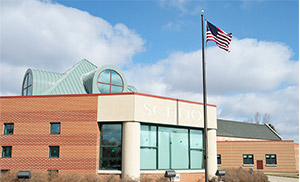Matheny student Daniel Gaudreau, assisted by Christine Mayercik, uses the eye tracker to click on a Taylor Swift music video.
Matheny student Daniel Gaudreau is able to select his favorite music videos by gazing at a computer screen. It’s part of a new indirect access communications program made possible by an $8,451 grant to the Matheny School from the Summit Area Public Foundation. With the grant, Matheny is training students with medically complex developmental disabilities to control a computer by using visual tracking and scanning technology.
Gaudreau is learning how to use this technology with assistance from Matheny speech-language pathologist Christine Mayercik. For example, he chooses Taylor Swift and Gangnam Style music videos over a video clip of President Barack Obama appearing on the David Letterman Show. “You need to look for two green lights,” Mayercik advises Gaudreau. “Then an arrow will take you to the next screen, and the finger pointer will take you to the video.”
The equipment used for this project was purchased with funds from the SAPF grant and has been set up on a dedicated computer table that will allow students easy access. “The trial group of students is using the eye tracker during therapy sessions,” Mayercik reports. “Students are able to maneuver the cursor around the screen and use either an eye blink or maintain the cursor in one spot for a predetermined amount of time to activate a mouse click. PowerPoint is used for practice activities where students have to use either one click, to change a slide moving through a presentation, or two clicks to activate an animation and then change slides.”
Once students become comfortable with this technology, they will be encouraged to begin using it during off-program hours with support from Matheny’s recreation therapy staff.
Teaching students to use technology such as the eye tracker system is integral to Matheny’s goal of improving the lives of its students and patients. This technology not only facilitates education and increases leisure activity options, it also enables unprecedented levels of communication between the students and patients and their teachers, family and community.



